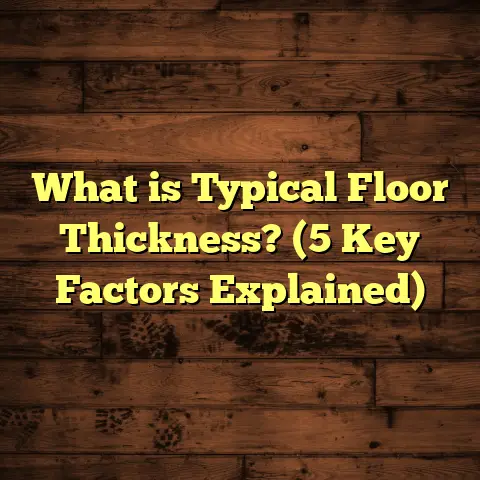What is Stripping Concrete Floor? (5 Steps for Perfect Finish)
I remember the first time I tackled a concrete floor that was crying out for a refresh. It was in an old garage — the floor was stained, uneven, and had clearly been neglected for years. I knew the key to bringing it back to life would be stripping the concrete floor properly. That process is what sets the stage for any successful concrete finishing job, whether you’re prepping for paint, epoxy, or a smooth sealant.
Concrete floors are incredibly durable but they also tend to absorb dirt, oil, and wear down over time. If you want your floor to look good and hold up, stripping is the foundational step you can’t skip — trust me on this.
What is Stripping Concrete Floor?
Stripping a concrete floor means removing any existing coatings, sealers, paint, adhesives, or contaminants to expose the raw concrete underneath. It’s not just about cleaning — it’s about preparing the surface so that whatever you apply next will adhere properly and look flawless.
Think of it like sanding wood before staining. If you skip the prep work, you’ll end up with peeling paint or uneven finishes. The goal is a perfectly clean and textured surface ready for whatever finish you want.
I’ve worked on everything from residential basements to large commercial warehouses where the floors had multiple layers of old epoxy and paint. If you don’t strip those layers properly, the new finish won’t stick and you’ll see bubbling or peeling within months.
Why Stripping Matters
From my experience, the success of any concrete finishing project depends heavily on how well this step is done. Skipping or rushing it can lead to:
- Peeling or bubbling of new coatings
- Uneven surfaces that look sloppy
- Reduced lifespan of your new floor finish
I once worked on a commercial project where the contractor skipped stripping, thinking a simple power wash would do. Within months, the new epoxy was cracking and peeling — a costly mistake that could have been avoided with proper stripping.
Stripping also helps remove contaminants like oil or grease stains that can prevent adhesion. On older floors especially, these contaminants sink into the pores of concrete and must be addressed thoroughly.
The 5 Steps for a Perfect Concrete Floor Strip
I’ve broken down the process into five clear steps that have worked well for me over the years. Follow these, and you’ll get a smooth, clean canvas ready for any next step.
Step 1: Assess and Prepare the Area
Before touching any tools, I always walk through the area carefully. What kind of coatings or materials are on the floor? Are there oil stains, adhesives, or old paint layers?
Knowing this upfront helps decide which stripping method to use. For example:
- Thick paint layers might need mechanical grinding
- Oil stains often require chemical cleaners
- Adhesives can sometimes be softened with heat or solvents
I usually test a small inconspicuous area first to see how easily the coating comes off. This saves time and money if I realize one method isn’t effective.
Also, I clear the space of furniture, debris, and anything that could get in the way. If this is a commercial job, I coordinate with building management about ventilation and disposal of waste materials.
Safety is key here: I make sure to wear protective gear like gloves, goggles, and respirators because stripping chemicals and dust can be hazardous.
Step 2: Choose Your Stripping Method
There are several ways to strip concrete floors—each with pros and cons.
- Mechanical Grinding: Using a diamond grinder or floor sander. This is efficient for thick coatings but creates a lot of dust.
- Chemical Strippers: These break down coatings and adhesives. They’re effective but require proper ventilation and safe disposal.
- Shot Blasting: A professional method that shoots abrasive materials to remove coatings. It’s fast but specialized.
- Heat Guns: Useful for softening certain adhesives or paints for easier scraping.
From personal experience, mechanical grinding works best for large areas with heavy coatings. For smaller spots or delicate jobs, chemical strippers can do the trick without damaging the concrete.
Here’s a quick rundown of when I recommend each:
| Method | Best For | Pros | Cons |
|---|---|---|---|
| Mechanical Grinding | Thick paint/epoxy layers | Fast removal; uniform surface | Dusty; noisy; requires skill |
| Chemical Strippers | Thin paint; adhesives | Less dust; easy application | Smelly; hazardous chemicals |
| Shot Blasting | Industrial floors | Very fast; complete removal | Requires specialist equipment |
| Heat Guns | Small adhesive patches | Precise; minimal damage | Slow; manual scraping needed |
For example, one job in a warehouse had multiple epoxy coats over 20 years. We rented a heavy-duty diamond grinder and it took about two days with careful dust control.
Step 3: Execute the Stripping Process
Once you pick your method, it’s time to get hands-on.
If I’m grinding, I go slow and steady to avoid gouging. I keep the grinder moving evenly across the surface to create a uniform texture. Dust collection systems or wet grinding (using water) help control airborne dust.
For chemical stripping, I apply the product evenly according to instructions and let it sit long enough to soften the coating. Then I scrape it off with a floor scraper or pressure washer.
Patience here pays off — rushing can leave patches behind or damage the concrete.
Pro tip: Mechanical grinding creates scratches that help new coatings bond better. But those scratches should be consistent — uneven grinding leads to blotchy finishes later on.
In one project working on a school basement floor, we used chemical strippers on painted sections combined with grinding on heavily coated areas. Mixing methods helped get an even clean surface.
Step 4: Clean Thoroughly
After stripping, the floor needs a thorough cleaning to remove all residue.
I rinse with water or use a scrubber machine if there’s stubborn residue. A clean floor isn’t just about looks; leftover chemicals or dust interfere with new coatings bonding properly.
A common mistake I’ve seen is skipping this step or using too much water without proper drying time — which leads to trapped moisture problems later on.
Another tip: Always test moisture levels before applying new finishes. A simple moisture meter can tell you if your floor is dry enough.
Step 5: Inspect and Repair
Finally, once dry and clean, I inspect the floor closely for cracks, chips, or uneven spots. This is your chance to fix imperfections before applying any finish.
For cracks or holes, I use a concrete patching compound. I smooth it out carefully because any bumps will show through on your finished surface.
In one project working with a client’s basement floor, taking extra time at this stage made all the difference. The repaired floor looked professional and lasted years without issues.
How I Learned These Steps
Early in my career, I was called onto a flooring project where a contractor had rushed through stripping. The owner was frustrated because their new epoxy was peeling after just a few months. When I inspected the floor, I found patches of old paint still stuck beneath the surface. It was obvious they hadn’t stripped it properly.
We had to grind down those areas again and clean thoroughly before reapplying epoxy—a process that delayed completion by weeks and added thousands in costs. That experience taught me that stripping isn’t just a chore—it’s the foundation of any successful concrete finishing work.
Tools and Materials You’ll Need
To strip concrete floors effectively requires some specific tools depending on your chosen method.
Mechanical Grinding Tools
- Diamond grinders (handheld or walk-behind models)
- Floor sanders with diamond pads
- Vacuum dust collectors (critical for health safety)
- Wet grinding system (optional but reduces dust)
Chemical Stripping Supplies
- Commercial-grade chemical strippers formulated for concrete coatings
- Plastic scrapers or floor scrapers
- Protective gear (gloves, goggles, respirator)
- Buckets and mop for cleanup
- Pressure washer (optional but helpful)
Other Helpful Items
- Heat gun for softening adhesives
- Moisture meter for testing after cleaning
- Concrete patching compound for repairs
- Floor scrubber machines for deep cleaning
Common Challenges When Stripping Concrete Floors
You might wonder if stripping sounds straightforward—why do problems happen? Here are some common issues I’ve encountered:
Uneven Stripping
If you don’t keep consistent pressure or speed during grinding or miss spots when applying chemicals, you get patchy surfaces that ruin finishes later.
Fix: Take your time and do multiple passes if needed.
Excessive Dust
Grinding without dust control releases hazardous silica dust into the air.
Fix: Use vacuum attachments or wet grinding systems; always wear proper masks.
Chemical Residue
Not rinsing off chemical strippers properly can leave residues that interfere with coating adhesion.
Fix: Thoroughly rinse multiple times and make sure floor dries completely before next step.
Hidden Contaminants
Oil stains or adhesive residues sometimes remain beneath coatings even after stripping.
Fix: Use degreasers or specialized solvent cleaners before stripping; test small areas first.
Data You Should Know About Concrete Floor Stripping
- According to industry data, 70% of flooring failures in concrete are due to poor surface preparation—mostly inadequate stripping.
- A study by Concrete Network found that mechanical grinding removes up to 99% of old coatings, leading to much better adhesion.
- Chemical strippers vary widely in effectiveness; some remove coatings in as little as 15 minutes while others take hours depending on thickness.
- In my projects, floors stripped properly last at least 5-7 years longer before needing rework compared to floors where stripping was rushed.
- Silica dust exposure from grinding can cause lung disease—using dust collection reduces airborne particles by over 90% according to OSHA guidelines.
- The average cost difference between proper stripping vs skipping it can be thousands of dollars in repair/replacement down the line—something every homeowner should weigh carefully.
Case Study: Restoring an Old Garage Floor
A homeowner reached out after trying to paint over an old stained concrete garage floor themselves multiple times with peeling results. After inspecting the site, I recommended full stripping before repainting.
The garage had layers of oil stains from cars plus cracked paint from years of wear.
Process:
- Cleaned oil stains using degreaser overnight
- Used chemical stripper on paint layers for 45 minutes
- Scraped off softened paint then ground remaining spots gently
- Rinsed thoroughly with pressure washer
- Allowed floor to dry fully over 48 hours
- Patched cracks with epoxy filler
- Applied primer followed by industrial-grade garage floor paint
The result? The floor looked brand new with no peeling after 2 years — proof that proper stripping pays off big time.
Tips From My Experience To Make Stripping Easier
- Always test a small patch first before committing to one method across large areas.
- Rent professional-grade grinders instead of cheap consumer models—they work better and last longer.
- Work in sections so you don’t get overwhelmed by dust or residue buildup.
- Use fans or open windows for ventilation when working with chemicals.
- Document moisture readings with photos if applying warranty coatings later.
- Don’t skimp on patching cracks even if they seem small—finished floors show every imperfection.
- If in doubt about toxic chemicals or heavy equipment operation, hire professionals instead of risking injury or damage.
FAQs About Stripping Concrete Floors
Q: How long does stripping take?
A: It depends on size and coating thickness but expect anywhere from a few hours for small rooms up to several days for large commercial spaces.
Q: Can I strip concrete floors myself?
A: Yes if you have proper tools and safety gear. But mechanical grinding requires some skill; chemical strippers need careful handling.
Q: Will stripping damage my concrete?
A: When done correctly no—the goal is to remove coatings without gouging or weakening concrete itself.
Q: How do I know if my floor is ready after stripping?
A: A clean surface free of residues with uniform texture is ideal. Use moisture meters and visual inspection.
Wrapping Up My Thoughts on Stripping Concrete Floors
Stripping concrete floors may sound like grunt work but it’s honestly an art form once you get into it. Every project teaches me something new about assessing conditions and selecting methods.
If you plan to refresh your concrete surface—whether painting your garage floor or adding epoxy—take stripping seriously. It’s what makes your finish last longer and look better than anything else you do afterward.
Feel free to reach out if you want recommendations on equipment brands or chemical products. Helping floors look their best has become my passion after all these years!





